How to install an interior door: installation instructions + tips for choosing interior doors
Each of us has doors in our house.And you will probably agree that modern interior doors no longer carry only a functional load - delimiting the internal space of an apartment; they are a design element that emphasizes the taste or the general concept of a living space. When the repair work on finishing the walls and ceiling, installing flooring and baseboards has already been completed, it’s time to choose, buy, and also solve the problem of how to install an interior door and what is needed for this.
Often this task becomes difficult to solve, since there are so many models and types of doors. You need to understand their quality, which option is more suitable in terms of design features, and will also fit into the budget. It is also necessary to be able to take correct measurements of doorways in order to select door of the right size.
If you have not yet decided which door models to choose for your apartment, then listen to the advice of experts. We will tell you what door designs exist, what materials are used to make them, and how to properly install a double-leaf swing and sliding door.
The content of the article:
Main types of doors
In terms of their structure, door leaf manufacturing technologies differ in design.They look different in appearance, although they can be made of the same materials.
Option No. 1 - paneled door structures
The most classic model is paneled. They are decorative and very diverse in appearance.
The main features are the presence of:
- wooden frame - strapping;
- jumpers located vertically;
- panels - figured planks from solid wood.
Sometimes panels can be partially replaced with glass or other decor.
This design is durable and has good sound insulation. It is resistant to changes in humidity, even if it is made of wood, as it consists of separate components. The fibers in them are multidirectional and compensate for temporary deformations that occur due to moisture or dryness.
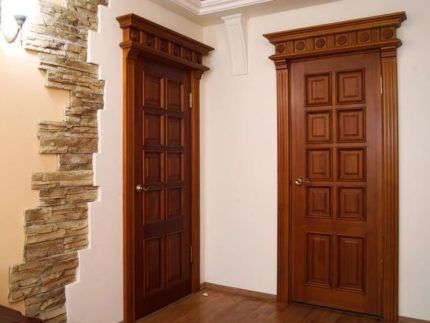
In this case, you can compromise and opt for a pine product. This is light wood, and modern coatings allow you to tint the surface as required by the interior design.
Paneled doors are also made of MDF or can be combined, using different materials, which allows you to choose an option that is suitable for price and appearance.
Option No. 2 - panel doors
A fairly budget-friendly type of door structure is panel models. They consist of elements such as:
- frame made of solid wood;
- sheathing, for example, MDF sheets;
- surface decor: veneer, laminate, PVC;
- filler.
The frame is usually made from pine or spruce bars - this is an inexpensive, light, but durable wood. MDF is a man-made material, but it is made from natural ingredients.
Finishing veneer makes the door more beautiful, although it increases the cost. Lamination and PVC film as decoration are quite impressive, although doors with such a coating are cheaper.
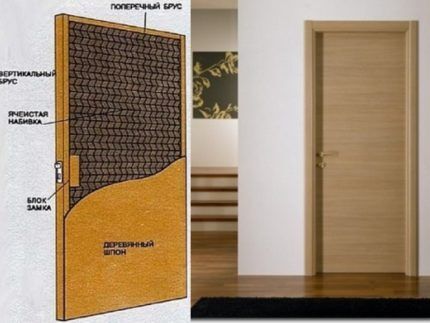
Option No. 3 - side doors made of MDF
Drawbar models are very popular. They are a prefabricated structure.
Tsar doors consist of: tsar - transverse strips and vertical posts. Horizontal elements are alternately inserted into the side ones using longitudinal tongues and grooves.
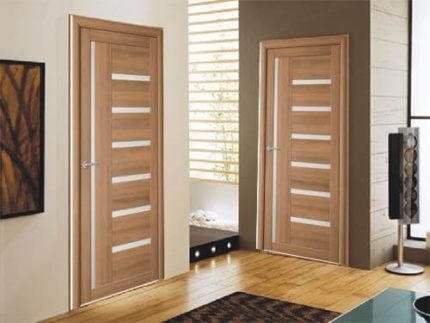
Each MDF part is covered with a protective film or laminated before assembly, so they have no edges and moisture will not get inside.
Option No. 4 - molded models
There is another modification of prefabricated doors, which is conventionally called molded. To be precise, door moldings include platbands, extensions, flashings, thresholds, and vertical pillars of the frame.
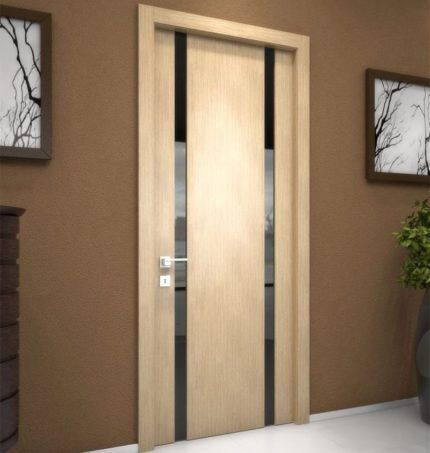
The parts, as in draw-bar models, are covered with a protective layer before assembly and have no edges.
Selection by type of material
Solid wood doors have many advantages, especially those made from valuable wood. This is, first of all, beauty. Aesthetically, they look very advantageous.
The advantages also include durability and good sound insulation. But the high price can be an obstacle, and you don’t often see these models on sale.Such products may be subject to changes in humidity.
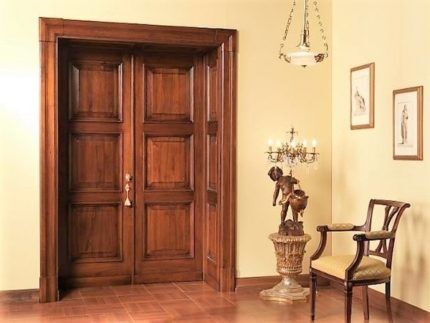
In addition to natural solid wood, laminated veneer lumber can be used in the manufacture of doors, and veneer can be used as finishing. Natural veneer is made by cutting a thin layer of natural wood.
Eco-veneer is made from a mixture of wood fibers and a polymer base using dyes. Modern European veneer covering is an artificial material made from a multilayer polymer that recreates the appearance of natural wood. It is resistant to fading from sunlight, non-toxic and does not burn.
MDF, from which different types of doors are made, is a fibreboard. Pressing occurs under high pressure without the use of synthetic binders.
In panel doors, chipboard can serve as fillers or stiffeners. Such structures are much heavier than those that use honeycomb filler or MDF or wooden blocks. Also, chipboard emits harmful substances and is undesirable to use indoors.
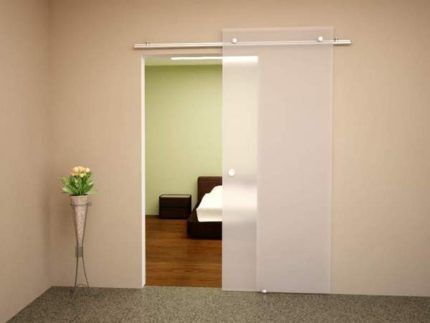
It should be borne in mind that glass doors require careful maintenance, as they quickly become dirty and have poor sound insulation.
You can also consider an economical option - plastic doors. They can also be in the form of a shield or composed of elements. Such doors are usually used for bathrooms where there is high humidity, on a limited budget, or as a temporary option.
The choice of one type of door or another depends on the size of the opening and the area of the room. The way they open is of great importance.
According to this principle they are:
- hinged with one or two doors;
- sliding roller single- and double-leaf;
- folding - accordions;
- folding books.
The most reliable and popular are swing doors. They can have one, one and a half, or two doors.
If there is no space, sliding doors are installed that roll parallel to the wall or into a specially made niche - pencil doors.
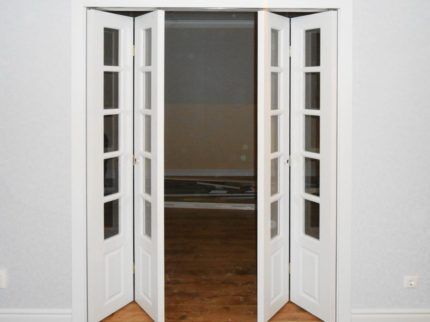
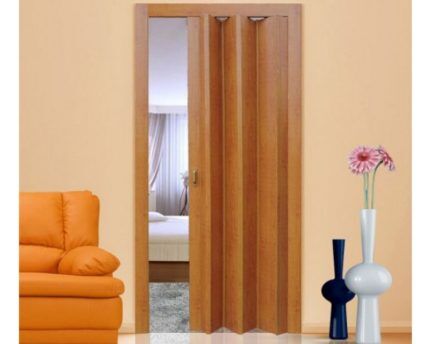
The accordion design folds when opened. They take up little space in width, but reduce the opening.
Installing interior doors yourself
First you need to decide on the size of the door; for this you need to take perfectly accurate measurements of the opening. And then follow the instructions exactly.
Stage No. 1 - measuring the opening
If old doors are replaced with new ones, then you first need to dismantle the door frame to determine the thickness and quality of the wall. If the opening is worn out, it needs to be strengthened, built up with timber or expanded, and therefore its size will change. If there is empty space in the opening above the door, then it is covered with plasterboard.
If the doors are installed in a new room, then it is enough to make the following measurements:
- the height of the opening (the floor covering must already be laid), measurement is made at three points; the minimum value is taken;
- opening width - you need to measure in three places, taking the minimum value;
- the wall thickness is replaced at six points and the maximum result is taken;
- difference in floor level at the junction, if any.
The dimensions of a standard door leaf are 200 cm high, width: from 60 to 90 cm in increments of 10 cm.
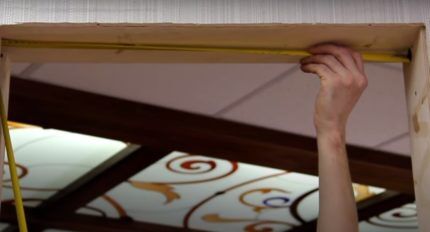
To calculate the height, you need to add the width of the box (1.5 - 4.5 cm) to the standard door height of 200 cm, plus the upper gap - 0.3 cm and the lower gap, depending on the floor covering from 0.5 cm to 1 .5 cm. That is, the height of the opening should be 200 cm plus 6-8 cm.
If the thickness of the wall in the opening is more than 7 cm, this is exactly the width of the standard box, in which case additional extensions will be needed. When the wall thickness is not greater than the width of the box, then only two sets of trims need to be installed.
Stage No. 2 - preparation for installation
After you have chosen the doors, you need to check their integrity, inspect for chips or scratches, cracks and other defects. As a rule, doors are delivered to the retail chain in packaging; if the packaging is not damaged, then the product should not be damaged.
After purchasing and delivering the doors to your home, there is no need to rush to install them. It needs to be kept in an upright position for several days to acclimatize.
Stage No. 3 - box assembly
Swinging double doors are usually installed at the entrance to a large room: living room, dining room. The installation technology and installation process are somewhat different from the work on single-leaf design.
When sawing a box with a simple profile, you can secure it with a clamp and use a miter box. For work, you need to use a hacksaw with fine teeth.
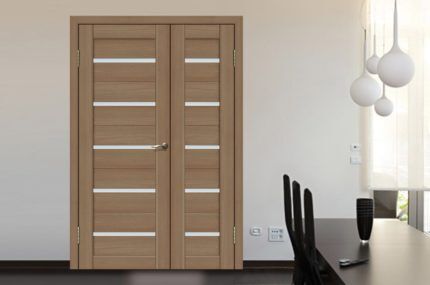
When preparing vertical beams, you need to cut across the thickened part, the so-called quarter, flush with the rest of the plane, and remove it with a chisel. The distance from the end of the rack to the cut point is equal to the thickness of the box. If, when making a cut, you hold the hacksaw at an angle to the front part, then the work will be done better. The top beam is sawed at an angle of 90°.
Its size should be two widths of the door leaf, plus 0.6-0.8 cm for remote clearances. The size of the upper part of the door frame is calculated by summing the width of the panels that will be installed and the technological gaps. For example, if the width of one door leaf is 70 cm, then in the upper part the length of the beam will be 140.8 cm.
Taking into account the design of the door and the shaped frame, a cut at an angle of 45° is used. To obtain a high-quality edge and an accurate angle, it should be done using a miter saw. If you don’t have one, then you can work with a hacksaw, but have a good miter box on hand. If you are not confident in your abilities, you should practice on a wooden block.
After the vertical elements have been cut, you need to make cuts on the horizontal ones.The length of the horizontal element along the lower edge should be equal to two widths of the canvas, plus 0.6 cm - the gap on the sides and 0.3 cm - the gap between the canvases, and along the upper edge, two more widths of the side part of the box must be added to this value. First, the cut is made from the side of the quarter, that is, the protruding part, and then from the side of the vestibule.

After cutting the box elements, you need to make a selection for the crossbar. First, markings are made with a pencil, and then recesses are made with a pen-shaped drill. The size of the recesses cannot be greater than the thickness of the crossbar. The holes must be evenly distributed, general alignment must be made and not reach the edges of the marking by 3 mm.
Final finishing is done using a chisel. This operation can be done with an electric cutter, and given a rectangular shape with a chisel. Once the groove is selected, crossbar inserted and secured with self-tapping screws into pre-drilled holes.
Assembly should be done on a clean, horizontal surface. In the places of proposed connections, holes with a diameter of 3-4 mm are drilled, and then the elements are fastened with self-tapping screws of a larger diameter.
You need to place the doors in the frame, maintaining 0.3 cm gaps around the perimeter and between the panels, using spacer inserts, for example, made from pieces of fiberboard. Next you should mark the location of the loops. They are usually made at a distance of 20-25 cm from the top and bottom edges. To insert hinges and install a lock, the structure must be disassembled.
Stage No. 4 - installation of hinges
The contours of the loops are applied to the surface of the end, in accordance with the previously applied markings.
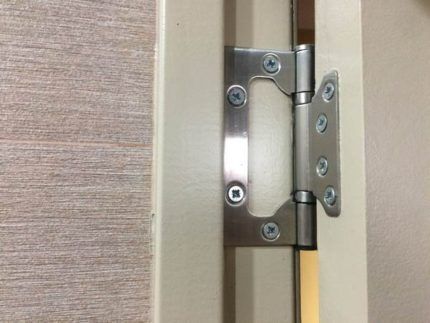
For other loops, an incision is made in the surface layer with a stationery knife. The decorative film is removed, and then a sample is taken to the depth of the thickness of the loop plate. If hinges are installed on solid wood doors, this must be done with great care, especially in knotty areas. The chisel must be struck lightly and from different positions. The insertion can be done using a milling tool.
For fastening, the loop is placed in the groove. When making holes, you should take a drill of a smaller diameter than a self-tapping screw, and shift the axis of the drill by a millimeter towards the quarter of the frame beam. This way the loop will adhere more closely to the surface along its entire length.
Stage No. 5 - installation of the door structure in the opening
To securely fasten the door frame in the opening, you can use long self-tapping screws. They are placed under the hinges and the locking plate on the vestibule. If this is not possible, then in any two or three places on vertical racks. The recessed heads of the screws are then decorated with special plugs that match the color. Lightweight doors, for example, made of MDF, can only be mounted on polyurethane foam.
First, one sash is attached to the hinge, on which the handle is attached. The box must be aligned using a level and plumb line. If the width of the wall is thicker than the frame and requires the installation of extensions, then it is aligned on the side where the door will open.
To impart temporary rigidity to the entire structure, wedges should be used. Then fixation will be provided by self-tapping screws and polyurethane foam.
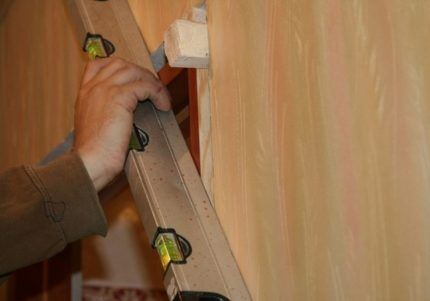
The door leaves are hung for more precise fixation. During the fitting process you will need to open and close them several times. All work on adjusting the angle of inclination and horizontal line requires patience and accuracy.
The locking plate under the crossbar should be installed after the frame is firmly secured. To do this, you first need to make spot fastenings with polyurethane foam, and then foam the entire contour.
The installation of handles and locks is carried out in the same way as when installing single-leaf doors, with the difference that the lock strike plate is placed on the second leaf. You can also install additional fasteners under the deadbolt locking plate to prevent the door frame from sagging in the center.
If you have decided to install a door with a lock, we suggest you familiarize yourself with the best methods open the door without a key.
Installation of sliding doors
When installing a sliding door structure, you should pay special attention to the perfect alignment of the floor surface with the lower edge of the door leaves and make sure that there are no distortions at the wall openings.
The upper guide is attached to a flat surface using brackets; if necessary, a flat, well-dried beam is first mounted in the opening, and then a guide profile is mounted to it.
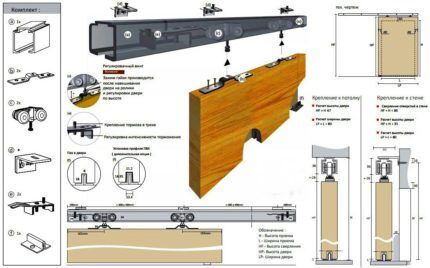
The length of the guide is determined based on double the width of the blade. You need to subtract 10 cm from this value. To mark the door, you need to place it vertically against the wall so that it is pressed tightly against it. In the closed position, markings are made along the top edge, then you need to move the canvas to the open position and apply the marks again. If the sizes at the marked points do not match, then you should focus on the ones farthest from the floor.
To determine where the top surface of the guide will be, you need to take the distance from the highest extreme points, add the width of the profile and add another 0.5 - 1 cm. You need to measure the result obtained from the applied markings upwards, and put down new marks.
The beam on which the guide will be should be 1-1.5 cm wider than the door leaf. This is necessary so that it will be better to attach the decor later. The lower plane of the block must be aligned with the measured points. If the wall is not completely level, then it is necessary to make a solid backing to fill the voids for a tight fit of the timber. If the unevenness is minor, then it should be fixed more tightly to the wall.
Before the beam is placed on the wall, it is necessary to attach a guide to it. In this case, it is necessary to ensure the straightness of the profile location. The center point of the block should be located exactly above the extreme point of the opening.

The plank is attached with self-tapping screws to the block in such a way that subsequently there remains a gap of 0.4-1 cm between the door and the wall.
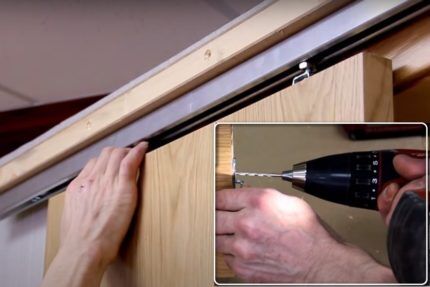
The door leaf is hung on rollers and the fastening is screwed on. At this stage, the blade should be adjusted by tightening the screws.
It is necessary to maintain a distance of 0.5-1 cm from the bottom edge of the door panel to the floor and adjust the vertical line of the door edge. Next, a fixing flag is fixed to the floor.
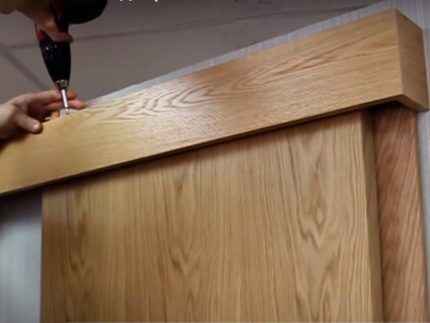
The doorway is finished with additional elements. The voids are filled with foam, which also secures them to the opening. Further along the perimeter the opening is finished with platbands.
Conclusions and useful video on the topic
An informative and useful video about choosing interior doors:
The first part of the video on installing a swing door, very detailed and clear instructions - assembling the frame, installing the hinges:
The second part of the video on installing a double swing door - installing locking hardware:
When choosing doors, attention should be paid to the design and appearance of the products, and decide whether they will suit the interior of the house. Evaluate options for different models not only by color or material, but also by type of design, availability of fittings, their performance, and cost. You should also think about how to install the door, do it yourself or trust the professionals.
Do you think we should do this ourselves? Will you cope with the task of installing the door frame and leaf after reading the article and watching the videos? What kind of door would you buy for your own apartment? Leave your comments below the article.



